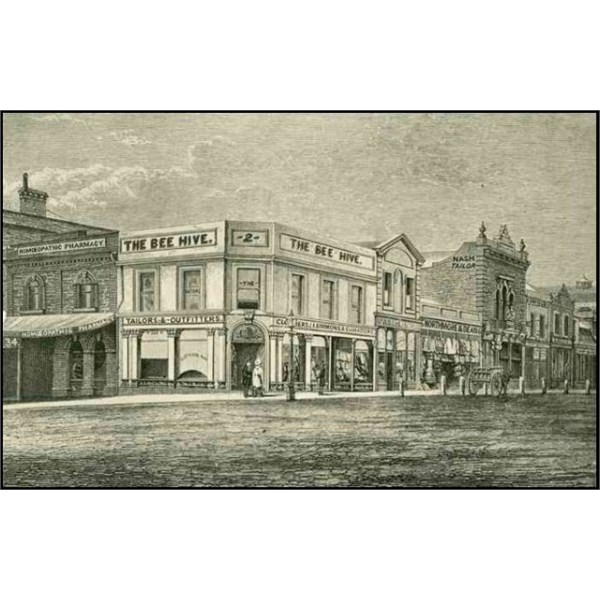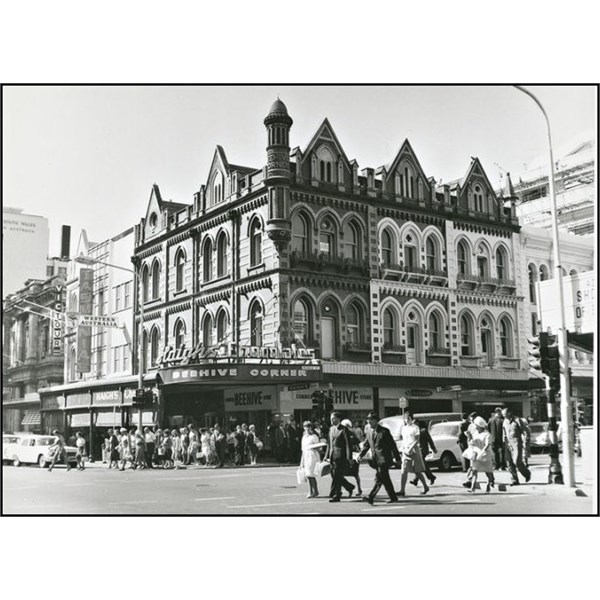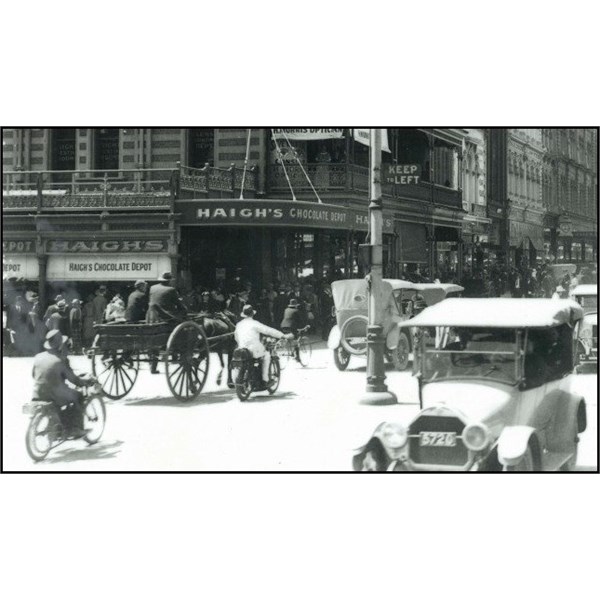The Beehive Corner is a landmark in the city of
Adelaide, South Australia, on the north-eastern corner of King William Street and Rundle Street, so centrally placed between the Railway Station and the city's shopping precinct.
The name gained currency from "The Beehive", a draper's
shop opened by Brewer and Robertson from October 1849 then J.V.B. Ryley from 1850 to 1858, followed by Israel Simmons (1831 – 9 June 1893) who ran the
shop until 1886, when his business, with many others, failed. According to one reference it had a beehive motif on the the glass door portrayed in gold leaf. Nearby tenants included Edmund Wright the
well-known architect, William Ekins the gunsmith and James Allen's printing
shop. The name is even older - archivist G. H. Pitt found the name was chosen by the original owners to denote a busy trading centre.

Corner of Rundle Street and King William Street, Adelaide
It had been a
well-known landmark for fifty years in 1895 when what is essentially the present Beehive Buildings were built for the owner, Henry Martin to replace the antiquated structure. In the new design, four shops had frontages on King William Street and three facing Rundle Street, each 8 ft. high, with jarrah floors and plastered walls and rear access and one
shop 14 ft. high, all having large plate-glass windows and nickel-plated columns. It was built three storeys above the pavement, and was Gothic in character, each gable finishing with crockets and a finial, and with open balustrades between them. At the main angle an ornamental turret was corbelled out, surmounted by a gilded beehive and bee and on the shaft of the turret the words 'Beehive Corner 1895' among foliage. The piers dividing the shopfronts were of Palmer
granite. Sliding shutters were fitted to the windows facing King William Street, with a handsome iron verandah made by Fulton & Co. The sills of the windows facing Rundle Street were fitted with a small iron railing. The architects were English & Soward.

John Rundle
From 1835 to 1843,
John Rundle was a Member of Parliament, representing Tavistock in the House of Commons. He was one of the original directors and financiers of the South Australia Company, the company that was formed in London in 1834 to promote
the settlement of the colony that was to become South Australia.
He arrived in South Australia at
Port Adelaide on 6 February 1840 aboard the Java, after a notorious journey during which between 30 and 50 passengers (the number varying between reports) starved to death.
Rundle Street and subsequently Rundle Mall bear his name. Beehive Corner, at the corner of Rundle Mall and King William Street, was owned by him. The historic building currently on this site was built later, in 1895.
On 13 April 1895 an article in the Observer reported on the disappearance of many of
Adelaide's early landmarks. Shops along King William Street, including the two-storey building on the Beehive Corner, 'familiar to Adelaideans for half a century', were being demolished to make way for new buildings. From 1849 the site was occupied by small shops amongst them, on the corner, a leading drapery
shop which was named the Beehive and had a gilt beehive decorating the front door. Other tenants included Edmund Wright, architect, Elkins, gunmaker, and behind his place the
Adelaide Times was printed. The paper was owned by James Allen, known as 'Dismal Jimmy', not because of his lugubrious expression, but because he carried on wearing a black stovepipe hat when cabbage tree hats were all the fashion. At the rear of another
shop an industrious woman made and sold kidney pies, until her useless husband killed her. In one
shop was a large 19 foot crocodile which could be viewed for a shilling, although it is not recorded if the reptile was alive or stuffed.

Beehive Corner

Beehive Corner Today

Beehive Corner Turret
The present Beehive Building was constructed in 1895-96 with the architects retaining the Beehive name in the corner turret.
The design is impressive because of the scale and location of the building and the use of abstracted Gothic forms and detail, finished in stucco in combination with face brickwork.
In 1896 the Beehive Corner building was used to exhibit the first moving pictures in
Adelaide, after the Theatre Royal proved an inappropriate venue.
Adelaide’s first electric street lighting was installed in October 1895 at the
intersection of Hindley Street, King William Street and Rundle Street while the building was being constructed.
In 1950 the prime corner section of the complex was sold to confectioner C. A. Haigh for his iconic
shop Haigh's Chocolates after his leasing it for some 35 years.

Rundle Street, Beehive Corner & Haigh's Chocolates
.